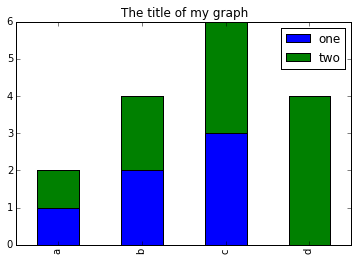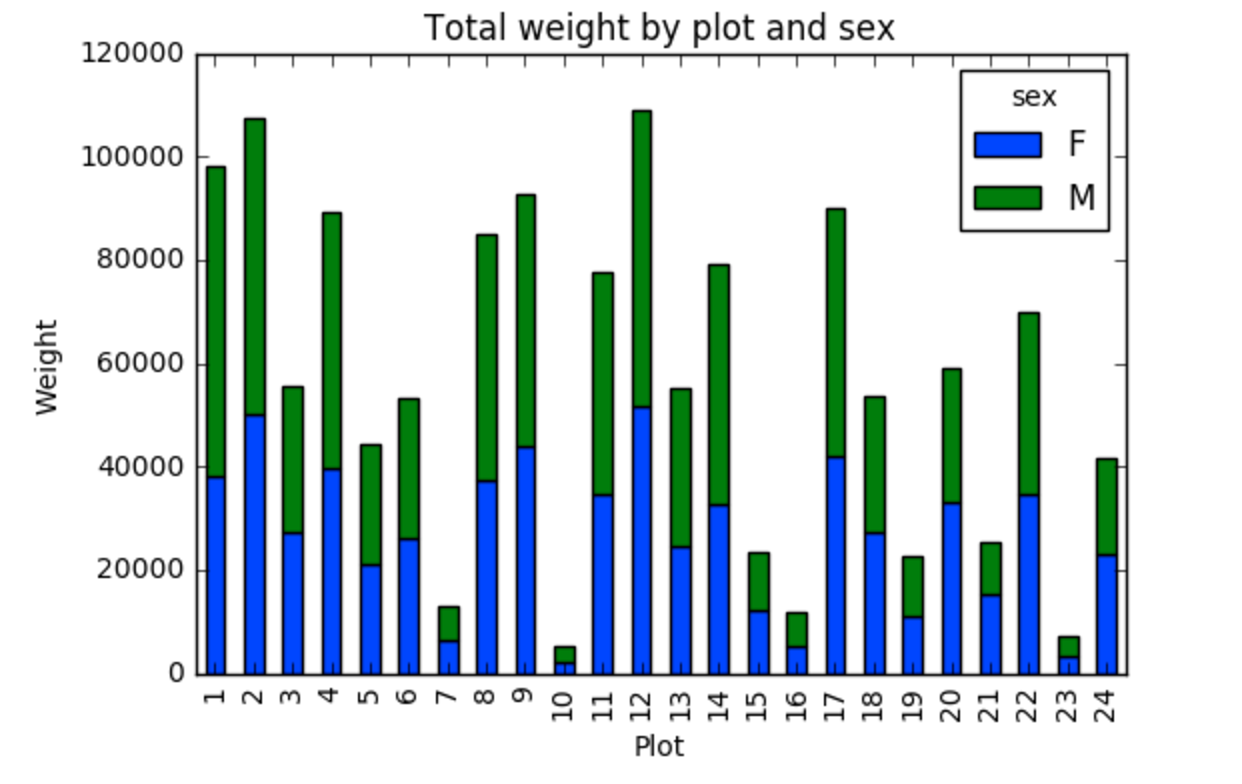Before we start
Overview
Teaching: 30 min
Exercises: 0 minQuestions
What is Python and why should I learn it?
Objectives
Present motivations for using Python.
Organize files and directories for a set of analyses as a Python project, and understand the purpose of the working directory.
How to work with Jupyter Notebook and Spyder.
Know where to find help.
Demonstrate how to provide sufficient information for troubleshooting with the Python user community.
What is Python?
Python is a general purpose programming language that supports rapid development of data analytics applications. The word “Python” is used to refer to both, the programming language and the tool that executes the scripts written in Python language.
Its main advantages are:
- Free
- Open-source
- Available on all major platforms (macOS, Linux, Windows)
- Supported by Python Software Foundation
- Supports multiple programming paradigms
- Has large community
- Rich ecosystem of third-party packages
So, why do you need Python for data analysis?
-
Easy to learn: Python is easier to learn than other programming languages. This is important because lower barriers mean it is easier for new members of the community to get up to speed.
-
Reproducibility: Reproducibility is the ability to obtain the same results using the same dataset(s) and analysis.
Data analysis written as a Python script can be reproduced on any platform. Moreover, if you collect more or correct existing data, you can quickly re-run your analysis!
An increasing number of journals and funding agencies expect analyses to be reproducible, so knowing Python will give you an edge with these requirements.
-
Versatility: Python is a versatile language that integrates with many existing applications to enable something completely amazing. For example, one can use Python to generate manuscripts, so that if you need to update your data, analysis procedure, or change something else, you can quickly regenerate all the figures and your manuscript will be updated automatically.
Python can read text files, connect to databases, and many other data formats, on your computer or on the web.
-
Interdisciplinary and extensible: Python provides a framework that allows anyone to combine approaches from different research (but not only) disciplines to best suit your analysis needs.
-
Python has a large and welcoming community: Thousands of people use Python daily. Many of them are willing to help you through mailing lists and websites, such as Stack Overflow and Anaconda community portal.
-
Free and Open-Source Software (FOSS)… and Cross-Platform: We know we have already said that but it is worth repeating.
Knowing your way around Anaconda
Anaconda distribution of Python includes a lot of its popular packages, such as the IPython console, Jupyter Notebook, and Spyder IDE. Have a quick look around the Anaconda Navigator. You can launch programs from the Navigator or use the command line.
The Jupyter Notebook is an open-source web application that allows you to create and share documents that allow one to create documents that combine code, graphs, and narrative text. Spyder is an Integrated Development Environment that allows one to write Python scripts and interact with the Python software from within a single interface.
Anaconda also comes with a package manager called conda, which makes it easy to install and update additional packages.
Research Project: Best Practices
It is a good idea to keep a set of related data, analyses, and text in a single folder. All scripts and text files within this folder can then use relative paths to the data files. Working this way makes it a lot easier to move around your project and share it with others.
Organizing your working directory
Using a consistent folder structure across your projects will help you keep things organized, and will also make it easy to find/file things in the future. This can be especially helpful when you have multiple projects. In general, you may wish to create separate directories for your scripts, data, and documents.
-
data/: Use this folder to store your raw data. For the sake of transparency and provenance, you should always keep a copy of your raw data. If you need to cleanup data, do it programmatically (i.e. with scripts) and make sure to separate cleaned up data from the raw data. For example, you can store raw data in files./data/raw/and clean data in./data/clean/. -
documents/: Use this folder to store outlines, drafts, and other text. -
code/: Use this folder to store your (Python) scripts for data cleaning, analysis, and plotting that you use in this particular project.
You may need to create additional directories depending on your project needs, but these should form
the backbone of your project’s directory. For this workshop, we will need a data/ folder to store
our raw data, and we will later create a data_output/ folder when we learn how to export data as
CSV files.
What is Programming and Coding?
Programming is the process of writing “programs” that a computer can execute and produce some (useful) output. Programming is a multi-step process that involves the following steps:
- Identifying the aspects of the real-world problem that can be solved computationally
- Identifying (the best) computational solution
- Implementing the solution in a specific computer language
- Testing, validating, and adjusting implemented solution.
While “Programming” refers to all of the above steps, “Coding” refers to step 3 only: “Implementing the solution in a specific computer language”. It’s important to note that “the best” computational solution must consider factors beyond the computer. Who is using the program, what resources/funds does your team have for this project, and the available timeline all shape and mold what “best” may be.
If you are working with Jupyter notebook:
You can type Python code into a code cell and then execute the code by pressing
Shift+Return.
Output will be printed directly under the input cell.
You can recognise a code cell by the In[ ]: at the beginning of the cell and output by Out[ ]:.
Pressing the + button in the menu bar will add a new cell.
All your commands as well as any output will be saved with the notebook.
If you are working with Spyder:
You can either use the console or use script files (plain text files that contain your code). The console pane (in Spyder, the bottom right panel) is the place where commands written in the Python language can be typed and executed immediately by the computer. It is also where the results will be shown. You can execute commands directly in the console by pressing Return, but they will be “lost” when you close the session. Spyder uses the IPython console by default.
Since we want our code and workflow to be reproducible, it is better to type the commands in the script editor, and save them as a script. This way, there is a complete record of what we did, and anyone (including our future selves!) has an easier time reproducing the results on their computer.
Spyder allows you to execute commands directly from the script editor by using the run buttons on top. To run the entire script click Run file or press F5, to run the current line click Run selection or current line or press F9, other run buttons allow to run script cells or go into debug mode. When using F9, the command on the current line in the script (indicated by the cursor) or all of the commands in the currently selected text will be sent to the console and executed.
At some point in your analysis you may want to check the content of a variable or the structure of an object, without necessarily keeping a record of it in your script. You can type these commands and execute them directly in the console. Spyder provides the Ctrl+Shift+E and Ctrl+Shift+I shortcuts to allow you to jump between the script and the console panes.
If Python is ready to accept commands, the IPython console shows an In [..]: prompt with the
current console line number in []. If it receives a command (by typing, copy-pasting or sent from
the script editor), Python will execute it, display the results in the Out [..]: cell, and come
back with a new In [..]: prompt waiting for new commands.
If Python is still waiting for you to enter more data because it isn’t complete yet, the console
will show a ...: prompt. It means that you haven’t finished entering a complete command. This can
be because you have not typed a closing parenthesis (), ], or }) or quotation mark. When this
happens, and you thought you finished typing your command, click inside the console window and press
Esc; this will cancel the incomplete command and return you to the In [..]: prompt.
How to learn more after the workshop?
The material we cover during this workshop will give you an initial taste of how you can use Python to analyze data for your own research. However, you will need to learn more to do advanced operations such as cleaning your dataset, using statistical methods, or creating beautiful graphics. The best way to become proficient and efficient at python, as with any other tool, is to use it to address your actual research questions. As a beginner, it can feel daunting to have to write a script from scratch, and given that many people make their code available online, modifying existing code to suit your purpose might make it easier for you to get started.
Seeking help
- check under the Help menu
- type
help() - type
?objectorhelp(object)to get information about an object - Python documentation
- Pandas documentation
Finally, a generic Google or internet search “Python task” will often either send you to the appropriate module documentation or a helpful forum where someone else has already asked your question.
I am stuck… I get an error message that I don’t understand. Start by googling the error message. However, this doesn’t always work very well, because often, package developers rely on the error catching provided by Python. You end up with general error messages that might not be very helpful to diagnose a problem (e.g. “subscript out of bounds”). If the message is very generic, you might also include the name of the function or package you’re using in your query.
However, you should check Stack Overflow. Search using the [python] tag. Most questions have already
been answered, but the challenge is to use the right words in the search to find the answers:
https://stackoverflow.com/questions/tagged/python?tab=Votes
Asking for help
The key to receiving help from someone is for them to rapidly grasp your problem. You should make it as easy as possible to pinpoint where the issue might be.
Try to use the correct words to describe your problem. For instance, a package is not the same thing as a library. Most people will understand what you meant, but others have really strong feelings about the difference in meaning. The key point is that it can make things confusing for people trying to help you. Be as precise as possible when describing your problem.
If possible, try to reduce what doesn’t work to a simple reproducible example. If you can reproduce the problem using a very small data frame instead of your 50,000 rows and 10,000 columns one, provide the small one with the description of your problem. When appropriate, try to generalize what you are doing so even people who are not in your field can understand the question. For instance, instead of using a subset of your real dataset, create a small (3 columns, 5 rows) generic one.
Where to ask for help?
- The person sitting next to you during the workshop. Don’t hesitate to talk to your neighbor during the workshop, compare your answers, and ask for help. You might also be interested in organizing regular meetings following the workshop to keep learning from each other.
- Your friendly colleagues: if you know someone with more experience than you, they might be able and willing to help you.
- Stack Overflow: if your question hasn’t been answered before and is well crafted, chances are you will get an answer in less than 5 min. Remember to follow their guidelines on how to ask a good question.
- Python mailing lists
More resources
Key Points
Python is an open source and platform independent programming language.
Jupyter Notebook and the Spyder IDE are great tools to code in and interact with Python. With the large Python community it is easy to find help on the internet.
Short Introduction to Programming in Python
Overview
Teaching: 30 min
Exercises: 5 minQuestions
How do I program in Python?
How can I represent my data in Python?
Objectives
Describe the advantages of using programming vs. completing repetitive tasks by hand.
Define the following data types in Python: strings, integers, and floats.
Perform mathematical operations in Python using basic operators.
Define the following as it relates to Python: lists, tuples, and dictionaries.
Interpreter
Python is an interpreted language which can be used in two ways:
- “Interactively”: when you use it as an “advanced calculator” executing
one command at a time. To start Python in this mode, execute
pythonon the command line:
$ python
Python 3.5.1 (default, Oct 23 2015, 18:05:06)
[GCC 4.8.3] on linux2
Type "help", "copyright", "credits" or "license" for more information.
>>>
Chevrons >>> indicate an interactive prompt in Python, meaning that it is waiting for your
input.
2 + 2
4
print("Hello World")
Hello World
- “Scripting” Mode: executing a series of “commands” saved in text file,
usually with a
.pyextension after the name of your file:
$ python my_script.py
Hello World
Introduction to variables in Python
Assigning values to variables
One of the most basic things we can do in Python is assign values to variables:
text = "Data Carpentry" # An example of assigning a value to a new text variable,
# also known as a string data type in Python
number = 42 # An example of assigning a numeric value, or an integer data type
pi_value = 3.1415 # An example of assigning a floating point value (the float data type)
Here we’ve assigned data to the variables text, number and pi_value,
using the assignment operator =. To review the value of a variable, we
can type the name of the variable into the interpreter and press Return:
text
"Data Carpentry"
Everything in Python has a type. To get the type of something, we can pass it
to the built-in function type:
type(text)
<class 'str'>
type(number)
<class 'int'>
type(pi_value)
<class 'float'>
The variable text is of type str, short for “string”. Strings hold
sequences of characters, which can be letters, numbers, punctuation
or more exotic forms of text (even emoji!).
We can also see the value of something using another built-in function, print:
print(text)
Data Carpentry
print(number)
42
This may seem redundant, but in fact it’s the only way to display output in a script:
example.py
# A Python script file
# Comments in Python start with #
# The next line assigns the string "Data Carpentry" to the variable "text".
text = "Data Carpentry"
# The next line does nothing!
text
# The next line uses the print function to print out the value we assigned to "text"
print(text)
Running the script
$ python example.py
Data Carpentry
Notice that “Data Carpentry” is printed only once.
Tip: print and type are built-in functions in Python. Later in this
lesson, we will introduce methods and user-defined functions. The Python
documentation is excellent for reference on the differences between them.
Types of Data
How information is stored in Python objects affects what we can do with it and the outputs of calculations as well. There are two main types of data that we will explore: numeric and text data types.
Text Data Type
The text data type is known as a string in Python, or object in pandas. Strings can
contain numbers and / or characters. For example, a string might be a word, a
sentence, or several sentences. A pandas object might also be a plot name like
'plot1'. A string can also contain or consist of numbers. For instance, '1234'
could be stored as a string, as could '10.23'. However strings that contain
numbers can not be used for mathematical operations!
Numeric Data Types
Numeric data types include integers and floats. A floating point (known as a float) number has decimal points even if that decimal point value is 0. For example: 1.13, 2.0, 1234.345. If we have a column that contains both integers and floating point numbers, pandas will assign the entire column to the float data type so the decimal points are not lost.
An integer will never have a decimal point. Thus if we wanted to store 1.13 as
an integer it would be stored as 1. Similarly, 1234.345 would be stored as 1234. You
will often see the data type Int64 in pandas which stands for 64 bit integer. The 64
refers to the memory allocated to store data in each cell which effectively
relates to how many digits it can store in each “cell”. Allocating space ahead of time
allows computers to optimize storage and processing efficiency.
So we’ve learned that computers store numbers in one of two ways: as integers or as floating-point numbers (or floats). Integers are the numbers we usually count with. Floats have fractional parts (decimal places). Let’s next consider how the data type can impact mathematical operations on our data. Addition, subtraction, division and multiplication work on floats and integers as we’d expect.
print(5+5)
10
print(24-4)
20
If we divide one integer by another, we get a float. The result on Python 3 is different than in Python 2, where the result is an integer (integer division).
print(5/9)
0.5555555555555556
print(10/3)
3.3333333333333335
We can also convert a floating point number to an integer or an integer to floating point number. Notice that Python by default rounds down when it converts from floating point to integer.
# Convert a to an integer
a = 7.83
int(a)
7
# Convert b to a float
b = 7
float(b)
7.0
Operators
We can perform mathematical calculations in Python using the basic operators
+, -, /, *, %:
2 + 2 # Addition
4
6 * 7 # Multiplication
42
2 ** 16 # Power
65536
13 % 5 # Modulo
3
We can also use comparison and logic operators:
<, >, ==, !=, <=, >= and statements of identity such as
and, or, not. The data type returned by this is
called a boolean.
3 > 4
False
True and True
True
True or False
True
True and False
False
Sequences: Lists and Tuples
Lists
Lists are a common data structure to hold an ordered sequence of elements. Each element can be accessed by an index. Note that Python indexes start with 0 instead of 1:
numbers = [1, 2, 3]
numbers[0]
1
A for loop can be used to access the elements in a list or other Python data
structure one at a time:
for num in numbers:
print(num)
1
2
3
Indentation is very important in Python. Note that the second line in the
example above is indented. Just like three chevrons >>> indicate an
interactive prompt in Python, the three dots ... are Python’s prompt for
multiple lines. This is Python’s way of marking a block of code. [Note: you
do not type >>> or ....]
To add elements to the end of a list, we can use the append method. Methods
are a way to interact with an object (a list, for example). We can invoke a
method using the dot . followed by the method name and a list of arguments
in parentheses. Let’s look at an example using append:
numbers.append(4)
print(numbers)
[1, 2, 3, 4]
To find out what methods are available for an
object, we can use the built-in help command:
help(numbers)
Help on list object:
class list(object)
| list() -> new empty list
| list(iterable) -> new list initialized from iterable's items
...
Tuples
A tuple is similar to a list in that it’s an ordered sequence of elements.
However, tuples can not be changed once created (they are “immutable”). Tuples
are created by placing comma-separated values inside parentheses ().
# Tuples use parentheses
a_tuple = (1, 2, 3)
another_tuple = ('blue', 'green', 'red')
# Note: lists use square brackets
a_list = [1, 2, 3]
Tuples vs. Lists
- What happens when you execute
a_list[1] = 5?- What happens when you execute
a_tuple[2] = 5?- What does
type(a_tuple)tell you abouta_tuple?- What information does the built-in function
len()provide? Does it provide the same information on both tuples and lists? Does thehelp()function confirm this?
Dictionaries
A dictionary is a container that holds pairs of objects - keys and values.
translation = {'one': 'first', 'two': 'second'}
translation['one']
'first'
Dictionaries work a lot like lists - except that you index them with keys. You can think about a key as a name or unique identifier for the value it corresponds to.
rev = {'first': 'one', 'second': 'two'}
rev['first']
'one'
To add an item to the dictionary we assign a value to a new key:
rev['third'] = 'three'
rev
{'first': 'one', 'second': 'two', 'third': 'three'}
Using for loops with dictionaries is a little more complicated. We can do
this in two ways:
for key, value in rev.items():
print(key, '->', value)
'first' -> one
'second' -> two
'third' -> three
or
for key in rev.keys():
print(key, '->', rev[key])
'first' -> one
'second' -> two
'third' -> three
Changing dictionaries
- First, print the value of the
revdictionary to the screen.- Reassign the value that corresponds to the key
secondso that it no longer reads “two” but instead2.- Print the value of
revto the screen again to see if the value has changed.
For loops
Loops allow us to repeat a workflow (or series of actions) a given number of times or while some condition is true. We would use a loop to automatically process data that’s stored in multiple files (daily values with one file per year, for example). Loops lighten our work load by performing repeated tasks without our direct involvement and make it less likely that we’ll introduce errors by making mistakes while processing each file by hand.
Let’s write a simple for loop that simulates what a kid might see during a visit to the zoo:
animals = ['lion', 'tiger', 'crocodile', 'vulture', 'hippo']
print(animals)
['lion', 'tiger', 'crocodile', 'vulture', 'hippo']
for creature in animals:
print(creature)
lion
tiger
crocodile
vulture
hippo
The line defining the loop must start with for and end with a colon, and the
body of the loop must be indented.
In this example, creature is the loop variable that takes the value of the next
entry in animals every time the loop goes around. We can call the loop variable
anything we like. After the loop finishes, the loop variable will still exist
and will have the value of the last entry in the collection:
animals = ['lion', 'tiger', 'crocodile', 'vulture', 'hippo']
for creature in animals:
pass
print('The loop variable is now: ' + creature)
The loop variable is now: hippo
We are not asking Python to print the value of the loop variable anymore, but
the for loop still runs and the value of creature changes on each pass through
the loop. The statement pass in the body of the loop means “do nothing”.
Challenge - Loops
What happens if we don’t include the
passstatement?Rewrite the loop so that the animals are separated by commas, not new lines (Hint: You can concatenate strings using a plus sign. For example,
print(string1 + string2)outputs ‘string1string2’).Suppose you have a list of number
xs = [3, 34, 23, 56, 14, 56]. Write a loop to sum the numbers of the list.
If Statements
The body of the test function now has two conditionals (if statements) that
check the values of start_year and end_year. If statements execute a segment
of code when some condition is met. They commonly look something like this:
a = 5
if a<0: # Meets first condition?
# if a IS less than zero
print('a is a negative number')
elif a>0: # Did not meet first condition. meets second condition?
# if a ISN'T less than zero and IS more than zero
print('a is a positive number')
else: # Met neither condition
# if a ISN'T less than zero and ISN'T more than zero
print('a must be zero!')
Which would return:
a is a positive number
Change the value of a to see how this function works. The statement elif
means “else if”, and all of the conditional statements must end in a colon.
The if statements in the function yearly_data_arg_test check whether there is an
object associated with the variable names start_year and end_year. If those
variables are None, the if statements return the boolean True and execute whatever
is in their body. On the other hand, if the variable names are associated with
some value (they got a number in the function call), the if statements return False
and do not execute. The opposite conditional statements, which would return
True if the variables were associated with objects (if they had received value
in the function call), would be if start_year and if end_year.
Challenge - Loops + If statements
Suppose you have a list of number
xs = [3, 34, 23, 56, 14, 56]. Write a loop to sum the even numbers from the list.
Functions
Defining a section of code as a function in Python is done using the def
keyword. For example a function that takes two arguments and returns their sum
can be defined as:
def add_function(a, b):
result = a + b
return result
z = add_function(20, 22)
print(z)
42
Key Points
Python is an interpreted language which can be used interactively (executing one command at a time) or in scripting mode (executing a series of commands saved in file).
One can assign a value to a variable in Python. Those variables can be of several types, such as string, integer, floating point and complex numbers.
Lists and tuples are similar in that they are ordered lists of elements; they differ in that a tuple is immutable (cannot be changed).
Dictionaries are data structures that provide mappings between keys and values.
Starting With Data
Overview
Teaching: 30 min
Exercises: 30 minQuestions
How can I import data in Python?
What is Pandas?
Why should I use Pandas to work with data?
Objectives
Navigate the workshop directory and download a dataset.
Explain what a library is and what libraries are used for.
Describe what the Python Data Analysis Library (Pandas) is.
Load the Python Data Analysis Library (Pandas).
Read tabular data into Python using Pandas.
Describe what a DataFrame is in Python.
Access and summarize data stored in a DataFrame.
Define indexing as it relates to data structures.
Perform basic mathematical operations and summary statistics on data in a Pandas DataFrame.
Create simple plots.
Working With Pandas DataFrames in Python
We can automate the process of performing data manipulations in Python. It’s efficient to spend time building the code to perform these tasks because once it’s built, we can use it over and over on different datasets that use a similar format. This makes our data manipulation processes reproducible. We can also share our code with colleagues and they can replicate the same analysis starting with the same original data.
Starting in the same spot
To help the lesson run smoothly, let’s ensure everyone is in the same directory. This should help us avoid path and file name issues. At this time please navigate to the workshop directory. If you are working in Jupyter Notebook be sure that you start your notebook in the workshop directory.
Our Data
For this lesson, we will be using the Portal Teaching data, a subset of the data from Ernst et al. Long-term monitoring and experimental manipulation of a Chihuahuan Desert ecosystem near Portal, Arizona, USA.
We will be using files from the Portal Project Teaching Database.
This section will use the surveys.csv file that can be downloaded here:
https://ndownloader.figshare.com/files/2292172
We are studying the species and weight of animals caught in sites in our study
area. The dataset is stored as a .csv file: each row holds information for a
single animal, and the columns represent:
| Column | Description |
|---|---|
| record_id | Unique id for the observation |
| month | month of observation |
| day | day of observation |
| year | year of observation |
| plot_id | ID of a particular site |
| species_id | 2-letter code |
| sex | sex of animal (“M”, “F”) |
| hindfoot_length | length of the hindfoot in mm |
| weight | weight of the animal in grams |
The first few rows of our first file look like this:
record_id,month,day,year,plot_id,species_id,sex,hindfoot_length,weight
1,7,16,1977,2,NL,M,32,
2,7,16,1977,3,NL,M,33,
3,7,16,1977,2,DM,F,37,
4,7,16,1977,7,DM,M,36,
5,7,16,1977,3,DM,M,35,
6,7,16,1977,1,PF,M,14,
7,7,16,1977,2,PE,F,,
8,7,16,1977,1,DM,M,37,
9,7,16,1977,1,DM,F,34,
About Libraries
A library in Python contains a set of tools (called functions) that perform tasks on our data. Importing a library is like getting a piece of lab equipment out of a storage locker and setting it up on the bench for use in a project. Once a library is set up, it can be used or called to perform the task(s) it was built to do.
Pandas in Python
One of the best options for working with tabular data in Python is to use the Python Data Analysis Library (a.k.a. Pandas). The Pandas library provides data structures, produces high quality plots with matplotlib and integrates nicely with other libraries that use NumPy (which is another Python library) arrays.
Python doesn’t load all of the libraries available to it by default. We have to
add an import statement to our code in order to use library functions. To import
a library, we use the syntax import libraryName. If we want to give the
library a nickname to shorten the command, we can add as nickNameHere. An
example of importing the pandas library using the common nickname pd is below.
import pandas as pd
Each time we call a function that’s in a library, we use the syntax
LibraryName.FunctionName. Adding the library name with a . before the
function name tells Python where to find the function. In the example above, we
have imported Pandas as pd. This means we don’t have to type out pandas each
time we call a Pandas function.
Reading CSV Data Using Pandas
We will begin by locating and reading our survey data which are in CSV format. CSV stands for
Comma-Separated Values and is a common way to store formatted data. Other symbols may also be used, so
you might see tab-separated, colon-separated or space separated files. pandas can work with each of these
types of separators, as it allows you to specify the appropriate separator for your data.
CSV files (and other -separated value file types) make it easy to share data, and can be imported and exported
from many applications, including Microsoft Excel. For more details on CSV
files, see the Data Organisation in Spreadsheets lesson.
We can use Pandas’ read_csv function to pull the file directly into a DataFrame.
So What’s a DataFrame?
A DataFrame is a 2-dimensional data structure that can store data of different
types (including characters, integers, floating point values, factors and more)
in columns. It is similar to a spreadsheet or an SQL table or the data.frame in
R. A DataFrame always has an index (0-based). An index refers to the position of
an element in the data structure.
# Note that pd.read_csv is used because we imported pandas as pd
pd.read_csv("data/surveys.csv")
The above command yields the output below:
record_id month day year plot_id species_id sex hindfoot_length weight
0 1 7 16 1977 2 NL M 32.0 NaN
1 2 7 16 1977 3 NL M 33.0 NaN
2 3 7 16 1977 2 DM F 37.0 NaN
3 4 7 16 1977 7 DM M 36.0 NaN
4 5 7 16 1977 3 DM M 35.0 NaN
... ... ... ... ... ... ... ... ... ...
35544 35545 12 31 2002 15 AH NaN NaN NaN
35545 35546 12 31 2002 15 AH NaN NaN NaN
35546 35547 12 31 2002 10 RM F 15.0 14.0
35547 35548 12 31 2002 7 DO M 36.0 51.0
35548 35549 12 31 2002 5 NaN NaN NaN NaN
[35549 rows x 9 columns]
We can see that there were 35,549 rows parsed. Each row has 9
columns. The first column is the index of the DataFrame. The index is used to
identify the position of the data, but it is not an actual column of the DataFrame.
It looks like the read_csv function in Pandas read our file properly. However,
we haven’t saved any data to memory so we can work with it. We need to assign the
DataFrame to a variable. Remember that a variable is a name for a value, such as x,
or data. We can create a new object with a variable name by assigning a value to it using =.
Let’s call the imported survey data surveys_df:
surveys_df = pd.read_csv("data/surveys.csv")
Note that Python does not produce any output on the screen when you assign the imported DataFrame to a variable.
We can view the value of the surveys_df
object by typing its name into the Python command prompt.
surveys_df
which prints contents like above.
Note: if the output is too wide to print on your narrow terminal window, you may see something slightly different as the large set of data scrolls past. You may see simply the last column of data:
17 NaN
18 NaN
19 NaN
20 NaN
21 NaN
22 NaN
23 NaN
24 NaN
25 NaN
26 NaN
27 NaN
28 NaN
29 NaN
... ...
35519 36.0
35520 48.0
35521 45.0
35522 44.0
35523 27.0
35524 26.0
35525 24.0
35526 43.0
35527 NaN
35528 25.0
35529 NaN
35530 NaN
35531 43.0
35532 48.0
35533 56.0
35534 53.0
35535 42.0
35536 46.0
35537 31.0
35538 68.0
35539 23.0
35540 31.0
35541 29.0
35542 34.0
35543 NaN
35544 NaN
35545 NaN
35546 14.0
35547 51.0
35548 NaN
[35549 rows x 9 columns]
Don’t worry: all the data is there! You can confirm this by scrolling upwards, or by
looking at the [# of rows x # of columns] block at the end of the output.
You can also use surveys_df.head() to view only the first few rows of the dataset in an output
that is easier to fit in one window. After doing this, you can see that pandas has neatly formatted
the data to fit our screen:
surveys_df.head() # The head() method displays the first several lines of a file. It
# is discussed below.
record_id month day year plot_id species_id sex hindfoot_length \
5 6 7 16 1977 1 PF M 14.0
6 7 7 16 1977 2 PE F NaN
7 8 7 16 1977 1 DM M 37.0
8 9 7 16 1977 1 DM F 34.0
9 10 7 16 1977 6 PF F 20.0
weight
5 NaN
6 NaN
7 NaN
8 NaN
9 NaN
Exploring Our Species Survey Data
Again, we can use the type function to see what kind of thing surveys_df is:
type(surveys_df)
<class 'pandas.core.frame.DataFrame'>
As expected, it’s a DataFrame (or, to use the full name that Python uses to refer
to it internally, a pandas.core.frame.DataFrame).
What kind of things does surveys_df contain? DataFrames have an attribute
called dtypes that answers this:
surveys_df.dtypes
record_id int64
month int64
day int64
year int64
plot_id int64
species_id object
sex object
hindfoot_length float64
weight float64
dtype: object
All the values in a single column have the same type. For example, values in the month
column have type int64, which is a kind of integer. Cells in the month column cannot have
fractional values, but values in weight and hindfoot_length columns can, because they
have type float64. The object type doesn’t have a very helpful name, but in
this case it represents strings (such as ‘M’ and ‘F’ in the case of sex).
pandas and base Python use slightly different names for data types. More on this is in the table below:
| Pandas Type | Native Python Type | Description |
|---|---|---|
| object | string | The most general dtype. Will be assigned to your column if column has mixed types (numbers and strings). |
| int64 | int | Numeric characters. 64 refers to the memory allocated to hold this character. |
| float64 | float | Numeric characters with decimals. If a column contains numbers and NaNs (see below), pandas will default to float64, in case your missing value has a decimal. |
| datetime64, timedelta[ns] | N/A (but see the datetime module in Python’s standard library) | Values meant to hold time data. Look into these for time series experiments. |
# Make sure pandas is loaded
import pandas as pd
# Note that pd.read_csv is used because we imported pandas as pd
surveys_df = pd.read_csv("data/surveys.csv")
Remember that we can check the type of an object like this:
type(surveys_df)
pandas.core.frame.DataFrame
Next, let’s look at the structure of our surveys_df data. In pandas, we can check
the type of one column in a DataFrame using the syntax
dataframe_name['column_name'].dtype:
surveys_df['sex'].dtype
dtype('O')
A type ‘O’ just stands for “object” which in pandas is a string (text).
surveys_df['record_id'].dtype
dtype('int64')
The type int64 tells us that pandas is storing each value within this column
as a 64 bit integer. We can use the dataframe_name.dtypes command to view the data type
for each column in a DataFrame (all at once).
surveys_df.dtypes
which returns:
record_id int64
month int64
day int64
year int64
plot_id int64
species_id object
sex object
hindfoot_length float64
weight float64
dtype: object
Note that most of the columns in our survey_df data are of type int64. This means
that they are 64 bit integers. But the weight column is a floating point value
which means it contains decimals. The species_id and sex columns are objects which
means they contain strings.
We can also modify the format of values within our data, if
we want. For instance, we could convert the record_id field to floating point
values.
# Convert the record_id field from an integer to a float
surveys_df['record_id'] = surveys_df['record_id'].astype('float64')
surveys_df['record_id'].dtype
dtype('float64')
Changing Types
Try converting the column
plot_idto floats usingsurveys_df['plot_id'].astype("float")Next try converting
weightto an integer. What goes wrong here? What is pandas telling you? We will talk about some solutions to this later.
Useful Ways to View DataFrame Objects in Python
There are many ways to summarize and access the data stored in DataFrames, using attributes and methods provided by the DataFrame object.
Attributes are features of an object. For example, the shape attribute will output
the size (the number of rows and columns) of an object. To access an attribute,
use the DataFrame object name followed by the attribute name df_object.attribute.
For example, using the DataFrame surveys_df and attribute columns, an index
of all the column names in the DataFrame can be accessed with surveys_df.columns.
Methods are like functions, but they only work on particular kinds of objects. As
an example, the head() method works on DataFrames. Methods are called in a
similar fashion to attributes, using the syntax df_object.method(). Using
surveys_df.head() gets the first few rows in the DataFrame surveys_df
using the head() method. With a method, we can supply extra information
in the parentheses to control behaviour.
Let’s look at the data using these.
Challenge - DataFrames
Using our DataFrame
surveys_df, try out the attributes & methods below to see what they return.
surveys_df.columns
surveys_df.shapeTake note of the output ofshape- what format does it return the shape of the DataFrame in?HINT: More on tuples, here.
surveys_df.head()Also, what doessurveys_df.head(15)do?surveys_df.tail()
Calculating Statistics From Data In A Pandas DataFrame
We’ve read our data into Python. Next, let’s perform some quick summary statistics to learn more about the data that we’re working with. We might want to know how many animals were collected in each site, or how many of each species were caught. We can perform summary stats quickly using groups. But first we need to figure out what we want to group by.
Let’s begin by exploring our data:
# Look at the column names
surveys_df.columns
which returns:
Index(['record_id', 'month', 'day', 'year', 'plot_id', 'species_id', 'sex',
'hindfoot_length', 'weight'],
dtype='object')
Let’s get a list of all the species. The pd.unique function tells us all of
the unique values in the species_id column.
pd.unique(surveys_df['species_id'])
which returns:
array(['NL', 'DM', 'PF', 'PE', 'DS', 'PP', 'SH', 'OT', 'DO', 'OX', 'SS',
'OL', 'RM', nan, 'SA', 'PM', 'AH', 'DX', 'AB', 'CB', 'CM', 'CQ',
'RF', 'PC', 'PG', 'PH', 'PU', 'CV', 'UR', 'UP', 'ZL', 'UL', 'CS',
'SC', 'BA', 'SF', 'RO', 'AS', 'SO', 'PI', 'ST', 'CU', 'SU', 'RX',
'PB', 'PL', 'PX', 'CT', 'US'], dtype=object)
Challenge - Statistics
Create a list of unique site ID’s (“plot_id”) found in the surveys data. Call it
site_names. How many unique sites are there in the data? How many unique species are in the data?What is the difference between
len(site_names)andsurveys_df['plot_id'].nunique()?
Groups in Pandas
We often want to calculate summary statistics grouped by subsets or attributes within fields of our data. For example, we might want to calculate the average weight of all individuals per site.
We can calculate basic statistics for all records in a single column using the syntax below:
surveys_df['weight'].describe()
gives output
count 32283.000000
mean 42.672428
std 36.631259
min 4.000000
25% 20.000000
50% 37.000000
75% 48.000000
max 280.000000
Name: weight, dtype: float64
We can also extract one specific metric if we wish:
surveys_df['weight'].min()
surveys_df['weight'].max()
surveys_df['weight'].mean()
surveys_df['weight'].std()
surveys_df['weight'].count()
But if we want to summarize by one or more variables, for example sex, we can
use Pandas’ .groupby method. Once we’ve created a groupby DataFrame, we
can quickly calculate summary statistics by a group of our choice.
# Group data by sex
grouped_data = surveys_df.groupby('sex')
The pandas function describe will return descriptive stats including: mean,
median, max, min, std and count for a particular column in the data. Pandas’
describe function will only return summary values for columns containing
numeric data.
# Summary statistics for all numeric columns by sex
grouped_data.describe()
# Provide the mean for each numeric column by sex
grouped_data.mean()
grouped_data.mean() OUTPUT:
record_id month day year plot_id \
sex
F 18036.412046 6.583047 16.007138 1990.644997 11.440854
M 17754.835601 6.392668 16.184286 1990.480401 11.098282
hindfoot_length weight
sex
F 28.836780 42.170555
M 29.709578 42.995379
The groupby command is powerful in that it allows us to quickly generate
summary stats.
Challenge - Summary Data
- How many recorded individuals are female
Fand how many maleM?- What happens when you group by two columns using the following syntax and then calculate mean values?
grouped_data2 = surveys_df.groupby(['plot_id', 'sex'])grouped_data2.mean()- Summarize weight values for each site in your data. HINT: you can use the following syntax to only create summary statistics for one column in your data.
by_site['weight'].describe()Did you get #3 right?
A Snippet of the Output from challenge 3 looks like:
site 1 count 1903.000000 mean 51.822911 std 38.176670 min 4.000000 25% 30.000000 50% 44.000000 75% 53.000000 max 231.000000 ...
Quickly Creating Summary Counts in Pandas
Let’s next count the number of samples for each species. We can do this in a few
ways, but we’ll use groupby combined with a count() method.
# Count the number of samples by species
species_counts = surveys_df.groupby('species_id')['record_id'].count()
print(species_counts)
Or, we can also count just the rows that have the species “DO”:
surveys_df.groupby('species_id')['record_id'].count()['DO']
Challenge - Make a list
What’s another way to create a list of species and associated
countof the records in the data? Hint: you can performcount,min, etc. functions on groupby DataFrames in the same way you can perform them on regular DataFrames.
Basic Math Functions
If we wanted to, we could apply a mathmatical operation like addition or division on an entire column of our data. For example, let’s multiply all weight values by 2.
# Multiply all weight values by 2
surveys_df['weight']*2
A more practical use of this might be to normalize the data according to a mean, area, or some other value calculated from our data.
Quick & Easy Plotting Data Using Pandas
We can plot our summary stats using Pandas, too.
# Make sure figures appear inline in Ipython Notebook
%matplotlib inline
# Create a quick bar chart
species_counts.plot(kind='bar');
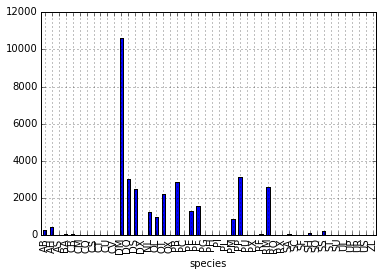 Count per species site
Count per species site
We can also look at how many animals were captured in each site:
total_count = surveys_df.groupby('plot_id')['record_id'].nunique()
# Let's plot that too
total_count.plot(kind='bar');
Challenge - Plots
- Create a plot of average weight across all species per site.
- Create a plot of total males versus total females for the entire dataset.
Summary Plotting Challenge
Create a stacked bar plot, with weight on the Y axis, and the stacked variable being sex. The plot should show total weight by sex for each site. Some tips are below to help you solve this challenge:
- For more information on pandas plots, see pandas’ documentation page on visualization.
- You can use the code that follows to create a stacked bar plot but the data to stack need to be in individual columns. Here’s a simple example with some data where ‘a’, ‘b’, and ‘c’ are the groups, and ‘one’ and ‘two’ are the subgroups.
d = {'one' : pd.Series([1., 2., 3.], index=['a', 'b', 'c']), 'two' : pd.Series([1., 2., 3., 4.], index=['a', 'b', 'c', 'd'])} pd.DataFrame(d)shows the following data
one two a 1 1 b 2 2 c 3 3 d NaN 4We can plot the above with
# Plot stacked data so columns 'one' and 'two' are stacked my_df = pd.DataFrame(d) my_df.plot(kind='bar', stacked=True, title="The title of my graph")
- You can use the
.unstack()method to transform grouped data into columns for each plotting. Try running.unstack()on some DataFrames above and see what it yields.Start by transforming the grouped data (by site and sex) into an unstacked layout, then create a stacked plot.
Solution to Summary Challenge
First we group data by site and by sex, and then calculate a total for each site.
by_site_sex = surveys_df.groupby(['plot_id', 'sex']) site_sex_count = by_site_sex['weight'].sum()This calculates the sums of weights for each sex within each site as a table
site sex plot_id sex 1 F 38253 M 59979 2 F 50144 M 57250 3 F 27251 M 28253 4 F 39796 M 49377 <other sites removed for brevity>Below we’ll use
.unstack()on our grouped data to figure out the total weight that each sex contributed to each site.by_site_sex = surveys_df.groupby(['plot_id', 'sex']) site_sex_count = by_site_sex['weight'].sum() site_sex_count.unstack()The
unstackmethod above will display the following output:sex F M plot_id 1 38253 59979 2 50144 57250 3 27251 28253 4 39796 49377 <other sites removed for brevity>Now, create a stacked bar plot with that data where the weights for each sex are stacked by site.
Rather than display it as a table, we can plot the above data by stacking the values of each sex as follows:
by_site_sex = surveys_df.groupby(['plot_id', 'sex']) site_sex_count = by_site_sex['weight'].sum() spc = site_sex_count.unstack() s_plot = spc.plot(kind='bar', stacked=True, title="Total weight by site and sex") s_plot.set_ylabel("Weight") s_plot.set_xlabel("Plot")
Key Points
Libraries enable us to extend the functionality of Python.
Pandas is a popular library for working with data.
A Dataframe is a Pandas data structure that allows one to access data by column (name or index) or row.
Aggregating data using the
groupby()function enables you to generate useful summaries of data quickly.Plots can be created from DataFrames or subsets of data that have been generated with
groupby().
Indexing, Slicing and Subsetting DataFrames in Python
Overview
Teaching: 30 min
Exercises: 30 minQuestions
How can I access specific data within my data set?
How can Python and Pandas help me to analyse my data?
Objectives
Describe what 0-based indexing is.
Manipulate and extract data using column headings and index locations.
Employ slicing to select sets of data from a DataFrame.
Employ label and integer-based indexing to select ranges of data in a dataframe.
Reassign values within subsets of a DataFrame.
Create a copy of a DataFrame.
Query / select a subset of data using a set of criteria using the following operators:
==,!=,>,<,>=,<=.Locate subsets of data using masks.
Describe BOOLEAN objects in Python and manipulate data using BOOLEANs.
In the first episode of this lesson, we read a CSV file into a pandas’ DataFrame. We learned how to:
- save a DataFrame to a named object,
- perform basic math on data,
- calculate summary statistics, and
- create plots based on the data we loaded into pandas.
In this lesson, we will explore ways to access different parts of the data using:
- indexing,
- slicing, and
- subsetting.
Loading our data
We will continue to use the surveys dataset that we worked with in the last episode. Let’s reopen and read in the data again:
# Make sure pandas is loaded
import pandas as pd
# Read in the survey CSV
surveys_df = pd.read_csv("data/surveys.csv")
Indexing and Slicing in Python
We often want to work with subsets of a DataFrame object. There are different ways to accomplish this including: using labels (column headings), numeric ranges, or specific x,y index locations.
Selecting data using Labels (Column Headings)
We use square brackets [] to select a subset of a Python object. For example,
we can select all data from a column named species_id from the surveys_df
DataFrame by name. There are two ways to do this:
# TIP: use the .head() method we saw earlier to make output shorter
# Method 1: select a 'subset' of the data using the column name
surveys_df['species_id']
# Method 2: use the column name as an 'attribute'; gives the same output
surveys_df.species_id
We can also create a new object that contains only the data within the
species_id column as follows:
# Creates an object, surveys_species, that only contains the `species_id` column
surveys_species = surveys_df['species_id']
We can pass a list of column names too, as an index to select columns in that order. This is useful when we need to reorganize our data.
NOTE: If a column name is not contained in the DataFrame, an exception (error) will be raised.
# Select the species and plot columns from the DataFrame
surveys_df[['species_id', 'plot_id']]
# What happens when you flip the order?
surveys_df[['plot_id', 'species_id']]
# What happens if you ask for a column that doesn't exist?
surveys_df['speciess']
Python tells us what type of error it is in the traceback, at the bottom it says
KeyError: 'speciess' which means that speciess is not a valid column name (nor a valid key in
the related Python data type dictionary).
Reminder
The Python language and its modules (such as Pandas) define reserved words that should not be used as identifiers when assigning objects and variable names. Examples of reserved words in Python include Boolean values
TrueandFalse, operatorsand,or, andnot, among others. The full list of reserved words for Python version 3 is provided at https://docs.python.org/3/reference/lexical_analysis.html#identifiers.When naming objects and variables, it’s also important to avoid using the names of built-in data structures and methods. For example, a list is a built-in data type. It is possible to use the word ‘list’ as an identifier for a new object, for example
list = ['apples', 'oranges', 'bananas']. However, you would then be unable to create an empty list usinglist()or convert a tuple to a list usinglist(sometuple).
Extracting Range based Subsets: Slicing
Reminder
Python uses 0-based indexing.
Let’s remind ourselves that Python uses 0-based
indexing. This means that the first element in an object is located at position
0. This is different from other tools like R and Matlab that index elements
within objects starting at 1.
# Create a list of numbers:
a = [1, 2, 3, 4, 5]


Challenge - Extracting data
What value does the code below return?
a[0]How about this:
a[5]In the example above, calling
a[5]returns an error. Why is that?What about?
a[len(a)]
Slicing Subsets of Rows in Python
Slicing using the [] operator selects a set of rows and/or columns from a
DataFrame. To slice out a set of rows, you use the following syntax:
data[start:stop]. When slicing in pandas the start bound is included in the
output. The stop bound is one step BEYOND the row you want to select. So if you
want to select rows 0, 1 and 2 your code would look like this:
# Select rows 0, 1, 2 (row 3 is not selected)
surveys_df[0:3]
The stop bound in Python is different from what you might be used to in languages like Matlab and R.
# Select the first 5 rows (rows 0, 1, 2, 3, 4)
surveys_df[:5]
# Select the last element in the list
# (the slice starts at the last element, and ends at the end of the list)
surveys_df[-1:]
We can also reassign values within subsets of our DataFrame.
But before we do that, let’s look at the difference between the concept of copying objects and the concept of referencing objects in Python.
Copying Objects vs Referencing Objects in Python
Let’s start with an example:
# Using the 'copy() method'
true_copy_surveys_df = surveys_df.copy()
# Using the '=' operator
ref_surveys_df = surveys_df
You might think that the code ref_surveys_df = surveys_df creates a fresh
distinct copy of the surveys_df DataFrame object. However, using the =
operator in the simple statement y = x does not create a copy of our
DataFrame. Instead, y = x creates a new variable y that references the
same object that x refers to. To state this another way, there is only
one object (the DataFrame), and both x and y refer to it.
In contrast, the copy() method for a DataFrame creates a true copy of the
DataFrame.
Let’s look at what happens when we reassign the values within a subset of the DataFrame that references another DataFrame object:
# Assign the value `0` to the first three rows of data in the DataFrame
ref_surveys_df[0:3] = 0
Let’s try the following code:
# ref_surveys_df was created using the '=' operator
ref_surveys_df.head()
# true_copy_surveys_df was created using the copy() function
true_copy_surveys_df.head()
# surveys_df is the original dataframe
surveys_df.head()
What is the difference between these three dataframes?
When we assigned the first 3 rows the value of 0 using the
ref_surveys_df DataFrame, the surveys_df DataFrame is modified too.
Remember we created the reference ref_surveys_df object above when we did
ref_surveys_df = surveys_df. Remember surveys_df and ref_surveys_df
refer to the same exact DataFrame object. If either one changes the object,
the other will see the same changes to the reference object.
However - true_copy_surveys_df was created via the copy() function.
It retains the original values for the first three rows.
To review and recap:
-
Copy uses the dataframe’s
copy()methodtrue_copy_surveys_df = surveys_df.copy() -
A Reference is created using the
=operatorref_surveys_df = surveys_df
Okay, that’s enough of that. Let’s create a brand new clean dataframe from the original data CSV file.
surveys_df = pd.read_csv("data/surveys.csv")
Slicing Subsets of Rows and Columns in Python
We can select specific ranges of our data in both the row and column directions using either label or integer-based indexing.
locis primarily label based indexing. Integers may be used but they are interpreted as a label.ilocis primarily integer based indexing
To select a subset of rows and columns from our DataFrame, we can use the
iloc method. For example, we can select month, day and year (columns 2, 3
and 4 if we start counting at 1), like this:
# iloc[row slicing, column slicing]
surveys_df.iloc[0:3, 1:4]
which gives the output
month day year
0 7 16 1977
1 7 16 1977
2 7 16 1977
Notice that we asked for a slice from 0:3. This yielded 3 rows of data. When you ask for 0:3, you are actually telling Python to start at index 0 and select rows 0, 1, 2 up to but not including 3.
Let’s explore some other ways to index and select subsets of data:
# Select all columns for rows of index values 0 and 10
surveys_df.loc[[0, 10], :]
# What does this do?
surveys_df.loc[0, ['species_id', 'plot_id', 'weight']]
# What happens when you type the code below?
surveys_df.loc[[0, 10, 35549], :]
NOTE: Labels must be found in the DataFrame or you will get a KeyError.
Indexing by labels loc differs from indexing by integers iloc.
With loc, both the start bound and the stop bound are inclusive. When using
loc, integers can be used, but the integers refer to the
index label and not the position. For example, using loc and select 1:4
will get a different result than using iloc to select rows 1:4.
We can also select a specific data value using a row and
column location within the DataFrame and iloc indexing:
# Syntax for iloc indexing to finding a specific data element
dat.iloc[row, column]
In this iloc example,
surveys_df.iloc[2, 6]
gives the output
'F'
Remember that Python indexing begins at 0. So, the index location [2, 6] selects the element that is 3 rows down and 7 columns over in the DataFrame.
It is worth noting that rows are selected when using loc with a single list of
labels (or iloc with a single list of integers). However, unlike loc or iloc,
indexing a data frame directly with labels will select columns (e.g.
surveys_df['species_id', 'plot_id', 'weight']), while ranges of integers will
select rows (e.g. surveys_df[0:13]). Direct indexing of rows is redundant with
using iloc, and will raise a KeyError if a single integer or list is used; the
error will also occur if index labels are used without loc (or column labels used
with it).
A useful rule of thumb is the following: integer-based slicing is best done with
iloc and will avoid errors (and is generally consistent with indexing of Numpy
arrays), label-based slicing of rows is done with loc, and slicing of columns by
directly indexing column names.
Challenge - Range
What happens when you execute:
surveys_df[0:1]surveys_df[0]surveys_df[:4]surveys_df[:-1]What happens when you call:
surveys_df.iloc[0:1]surveys_df.iloc[0]surveys_df.iloc[:4, :]surveys_df.iloc[0:4, 1:4]surveys_df.loc[0:4, 1:4]
- How are the last two commands different?
Subsetting Data using Criteria
We can also select a subset of our data using criteria. For example, we can select all rows that have a year value of 2002:
surveys_df[surveys_df.year == 2002]
Which produces the following output:
record_id month day year plot_id species_id sex hindfoot_length weight
33320 33321 1 12 2002 1 DM M 38 44
33321 33322 1 12 2002 1 DO M 37 58
33322 33323 1 12 2002 1 PB M 28 45
33323 33324 1 12 2002 1 AB NaN NaN NaN
33324 33325 1 12 2002 1 DO M 35 29
...
35544 35545 12 31 2002 15 AH NaN NaN NaN
35545 35546 12 31 2002 15 AH NaN NaN NaN
35546 35547 12 31 2002 10 RM F 15 14
35547 35548 12 31 2002 7 DO M 36 51
35548 35549 12 31 2002 5 NaN NaN NaN NaN
[2229 rows x 9 columns]
Or we can select all rows that do not contain the year 2002:
surveys_df[surveys_df.year != 2002]
We can define sets of criteria too:
surveys_df[(surveys_df.year >= 1980) & (surveys_df.year <= 1985)]
Python Syntax Cheat Sheet
We can use the syntax below when querying data by criteria from a DataFrame. Experiment with selecting various subsets of the “surveys” data.
- Equals:
== - Not equals:
!= - Greater than, less than:
>or< - Greater than or equal to
>= - Less than or equal to
<=
Challenge - Queries
Select a subset of rows in the
surveys_dfDataFrame that contain data from the year 1999 and that contain weight values less than or equal to 8. How many rows did you end up with? What did your neighbor get?You can use the
isincommand in Python to query a DataFrame based upon a list of values as follows:surveys_df[surveys_df['species_id'].isin([listGoesHere])]Use the
isinfunction to find all plots that contain particular species in the “surveys” DataFrame. How many records contain these values?
Experiment with other queries. Create a query that finds all rows with a weight value > or equal to 0.
The
~symbol in Python can be used to return the OPPOSITE of the selection that you specify in Python. It is equivalent to is not in. Write a query that selects all rows with sex NOT equal to ‘M’ or ‘F’ in the “surveys” data.
Using masks to identify a specific condition
A mask can be useful to locate where a particular subset of values exist or
don’t exist - for example, NaN, or “Not a Number” values. To understand masks,
we also need to understand BOOLEAN objects in Python.
Boolean values include True or False. For example,
# Set x to 5
x = 5
# What does the code below return?
x > 5
# How about this?
x == 5
When we ask Python whether x is greater than 5, it returns False.
This is Python’s way to say “No”. Indeed, the value of x is 5,
and 5 is not greater than 5.
To create a boolean mask:
- Set the True / False criteria (e.g.
values > 5 = True) - Python will then assess each value in the object to determine whether the value meets the criteria (True) or not (False).
- Python creates an output object that is the same shape as the original
object, but with a
TrueorFalsevalue for each index location.
Let’s try this out. Let’s identify all locations in the survey data that have
null (missing or NaN) data values. We can use the isnull method to do this.
The isnull method will compare each cell with a null value. If an element
has a null value, it will be assigned a value of True in the output object.
pd.isnull(surveys_df)
A snippet of the output is below:
record_id month day year plot_id species_id sex hindfoot_length weight
0 False False False False False False False False True
1 False False False False False False False False True
2 False False False False False False False False True
3 False False False False False False False False True
4 False False False False False False False False True
[35549 rows x 9 columns]
To select the rows where there are null values, we can use the mask as an index to subset our data as follows:
# To select just the rows with NaN values, we can use the 'any()' method
surveys_df[pd.isnull(surveys_df).any(axis=1)]
Note that the weight column of our DataFrame contains many null or NaN
values.
We can run isnull on a particular column too. What does the code below do?
# What does this do?
empty_weights = surveys_df[pd.isnull(surveys_df['weight'])]['weight']
print(empty_weights)
Let’s take a minute to look at the statement above. We are using the Boolean
object pd.isnull(surveys_df['weight']) as an index to surveys_df. We are
asking Python to select rows that have a NaN value of weight.
Challenge - Putting it all together
Create a new DataFrame that only contains observations with sex values that are not female or male. Print the number of rows in this new DataFrame. Verify the result by comparing the number of rows in the new DataFrame with the number of rows in the surveys DataFrame where sex is null.
Create a new DataFrame that contains only observations that are of sex male or female and where weight values are greater than 0. Create a stacked bar plot of average weight by plot with male vs female values stacked for each plot.
Key Points
In Python, portions of data can be accessed using indices, slices, column headings, and condition-based subsetting.
Python uses 0-based indexing, in which the first element in a list, tuple or any other data structure has an index of 0.
Pandas enables common data exploration steps such as data indexing, slicing and conditional subsetting.
Making Plots With matplotlib/seaborn
Overview
Teaching: min
Exercises: minQuestions
How can I visualize data in Python?
Objectives
Create default
seabornplotsSet universal plot settings.
Modify existing plots.
Change the aesthetics of a plot such as color.
Edit the axis labels.
Build complex plots using a step-by-step approach.
Create scatter plots, box plots, and time series plots.
Create customized plot styles to meet their needs.
Python has powerful built-in plotting capabilities with the matplotlib library.
For this episode, we will be using the seaborn
package, which is built on top of Matplotlib and interacts well with Pandas.
There are other plotting packages but these are the two most popular.
Another popular one is plotnine, which is inspired by the ggplot2 plotting library in R.
For some material on this library, you can have a look at the source of this material that uses plotnine
here.
Going back to seaborn, just as with the other packages, seaborn needs to be imported. Here we will import
both matplotlib and seaborn. It is good
practice to not just load an entire package such as from seaborn import *,
but to use an abbreviation as we used pd for Pandas:
%matplotlib inline
import matplotlib.pyplot as plt
import seaborn as sns
From now on, the functions of seaborn are available using sns. and matplotlib as plt..
For the exercise, we will use the surveys.csv data set, with the NA values removed
import pandas as pd
surveys_complete = pd.read_csv('data/surveys.csv')
surveys_complete = surveys_complete.dropna()
Plotting with matplotlib/seaborn
The seaborn package supports the creation of complex plots from data in a
dataframe. It uses default settings, which help creating publication quality
plots with a minimal amount of settings and tweaking.
Before we use the seaborn package, let’s just do the simplest plot we can do in Python
using the built-in matplotlib. Most plots in matplotlib are based on explicitly passing the arrays for the x-values
and y-values that will make up the points or lines of the plots. For example, to plot the weight versus the hindfoot length
from our surveys data we will need to extract them from the dataframe and pass them to the plotting function:
plt.scatter(x=surveys_complete["weight"], y=surveys_complete["hindfoot_length"])
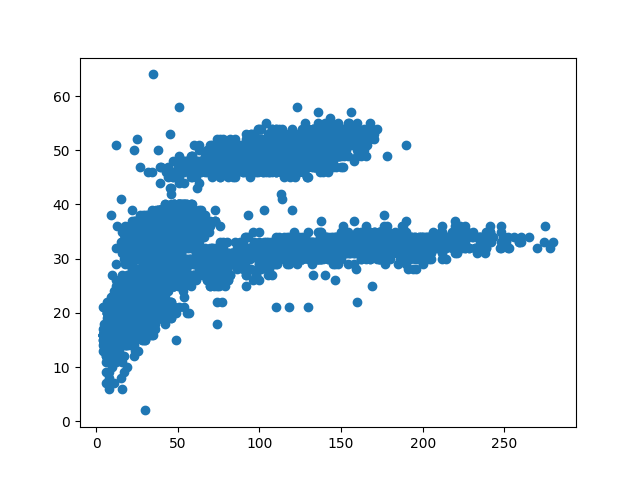
Because seaborn integrates well with pandas we can define our data object (the dataframe) and then assign column names to
x and y values of the plot. So the same thing with seaborn is:
sns.scatterplot(data=surveys_complete, x="weight", y="hindfoot_length")
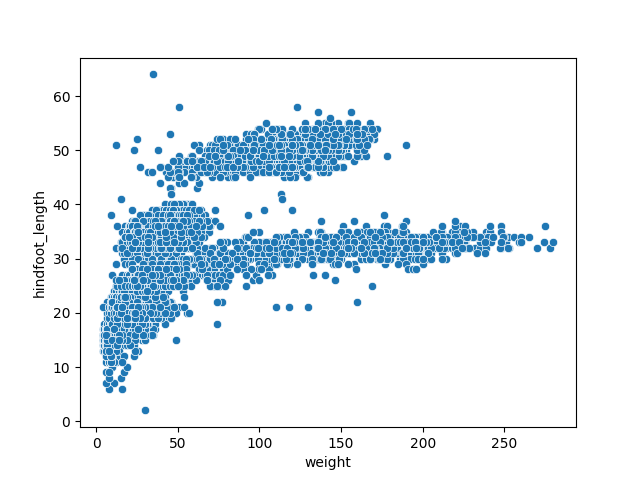
Building your plots iteratively
Building plots and interactive visualisation is typically an iterative process. So we would plot something initially but then depending on the results modify various parameters to, for example, see more clearly what we want.
We start by the same scatterplot we did before:
sns.scatterplot(data=surveys_complete, x="weight", y="hindfoot_length")

Then, we start modifying this plot to extract more information from it. For instance, we can add transparency (alpha) to avoid overplotting:
sns.scatterplot(data=surveys_complete, x="weight", y="hindfoot_length", alpha=0.5)
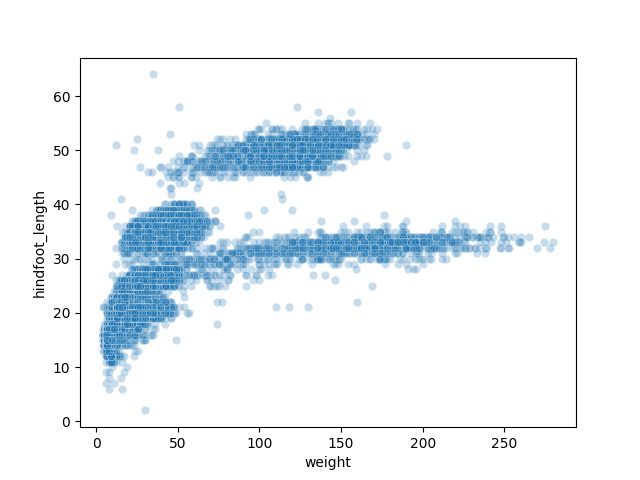
We can also add a different colour for all the points:
sns.scatterplot(data=surveys_complete, x="weight", y="hindfoot_length", alpha=0.25, color="red")
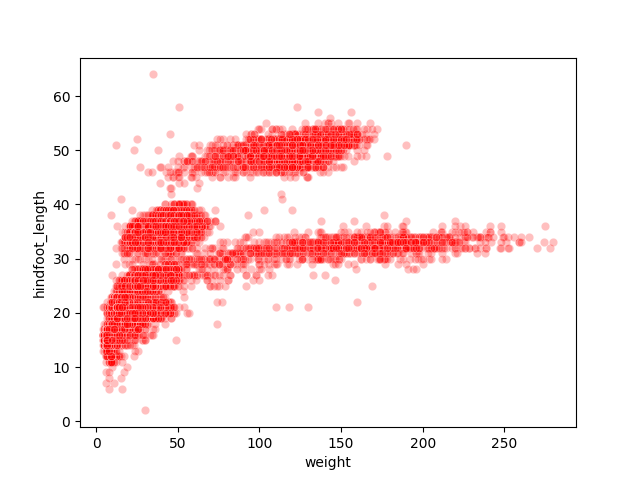
Or to color each species in the plot differently, we can map the species_id column to the color (hue):
sns.scatterplot(data=surveys_complete, x="weight", y="hindfoot_length", hue="species_id", alpha=0.25)
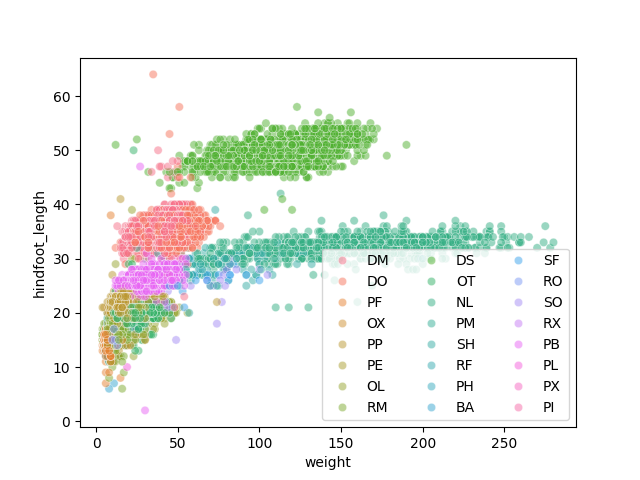
Apart from the adaptations of the arguments and settings of the seaborn plot, additional plot-level elements can be added and controlled as well. Here, it might be useful to have access to plot-level objects like the axes to set things like axes labels and so on. So we will create a figure and axes object with the built-in matplotlib so we have access to them and then pass them to seaborn for plotting. We will then use these objects to change the label of the x axis and the legend appearance:
fig = plt.figure()
ax = fig.add_subplot()
sns.scatterplot(data=surveys_complete, x="weight", y="hindfoot_length",
alpha=0.5, hue="species_id", ax=ax)
ax.set_xlabel("Weight (g)")
plt.legend(ncol=3)
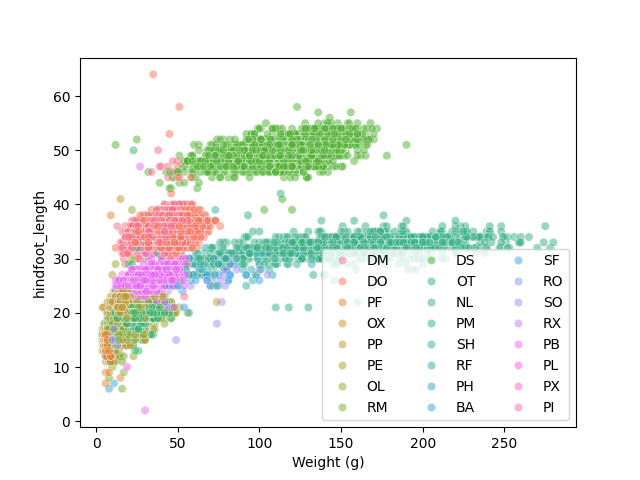
Challenge - Bar plots
Working on the surveys_complete data set, use the plot-id column to create a bar-plot that counts the number of records for each plot. (Check the documentation of the barplot to handle the counts)
(see in general API reference to find the appropriate plotting function).
Answers
sns.countplot(data=surveys_complete, x="plot_id", hue="sex")
Plotting distributions
Visualizing distributions is a common task during data exploration and
analysis. To visualize the distribution of weight within each species_id
group, a boxplot can be used:
sns.boxplot(data=surveys_complete, x="species_id", y="weight")
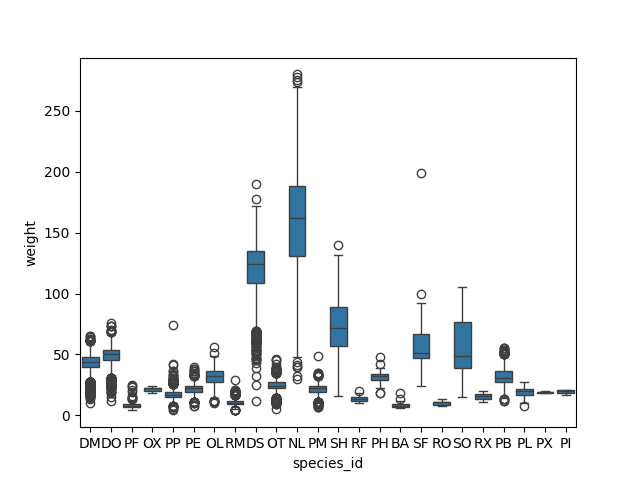
By plotting the points of the individual observations, we can have a better idea of the number of measurements and of their distribution:
sns.stripplot(data=surveys_complete, x="species_id", y="weight")
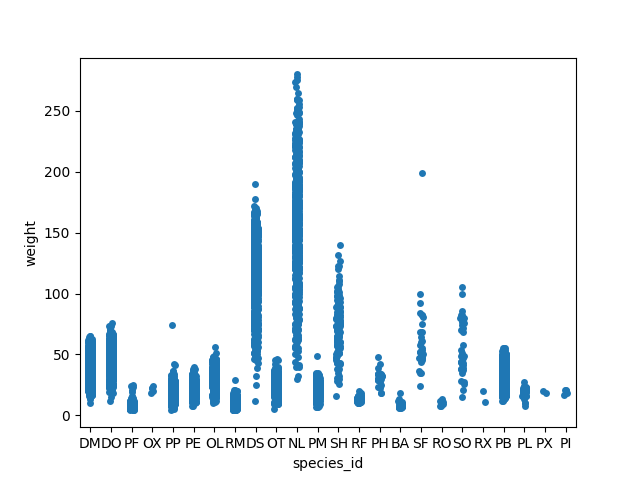
Sometimes boxplots can hide the ‘shape’ of the distribution. Violinplots can be used instead. See the full tutorial for plotting distribution data using seaborn including histograms and 2D distributions.
Plotting time series data
Let’s calculate number of counts per year for each species. To do that we need
to group data first and count the species (species_id) within each group.
yearly_counts = surveys_complete.groupby(['year', 'species_id'])['species_id'].count()
yearly_counts
When checking the result of the previous calculation, we actually have both the
year and the species_id as a row index. We can reset this index to use both
as column variable:
yearly_counts = yearly_counts.reset_index(name='counts')
yearly_counts
Timelapse data can be visualised as a line plot with years on x
axis and counts on the y axis.
sns.lineplot(data=yearly_counts, x='year', y='counts', hue='species_id')
plt.legend(ncol=3)
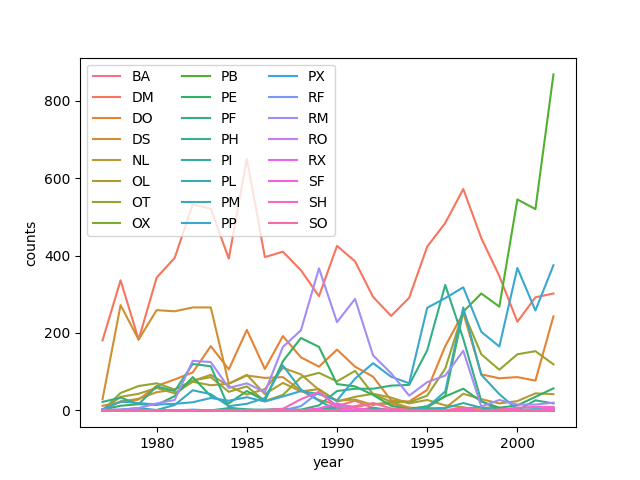
Faceting
As with other plotting libraries, seaborn also has a
special technique called faceting that allows to split one plot into multiple
plots based on a factor variable included in the dataset.
Consider our scatter plot of the weight versus the hindfoot_length from the
previous sections:
sns.scatterplot(data=surveys_complete, x="weight", y="hindfoot_length")

We can now keep the same code and at the facet_wrap on a chosen variable to
split out the graph and make a separate graph for each of the groups in that
variable. As an example, use sex:
sns.relplot(data=surveys_complete, x="weight", y="hindfoot_length",
col="sex", hue="species_id")
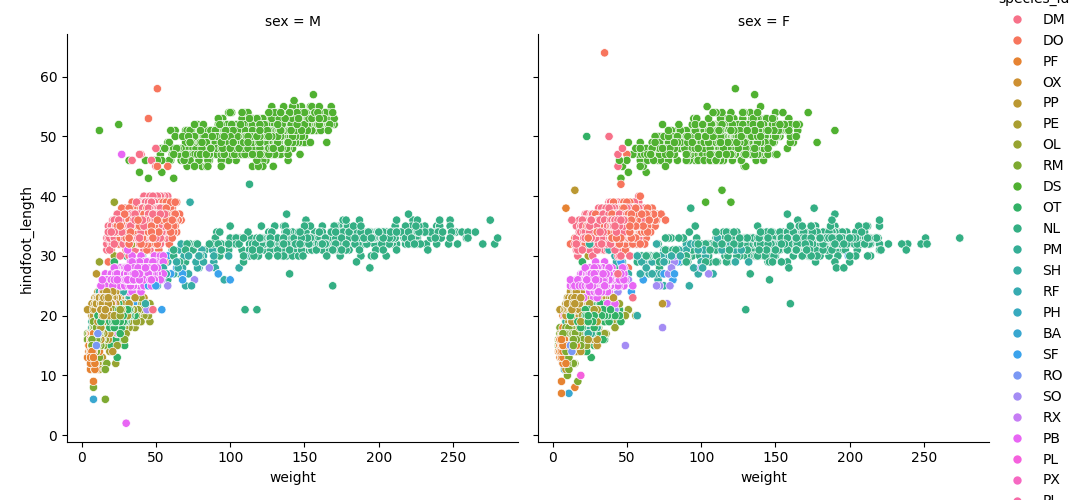
Note that we switched to the relplot figure-level function to do the facetting instead of using axis-level functions like
scatterplot and lineplot.
We can apply the same concept on any of the available categorical variables:
sns.relplot(data=surveys_complete, x="weight", y="hindfoot_length",
col="plot_id", hue="species_id", col_wrap=5)
Note that we use the col_wrap parameter to wrap the plots to multiple rows.
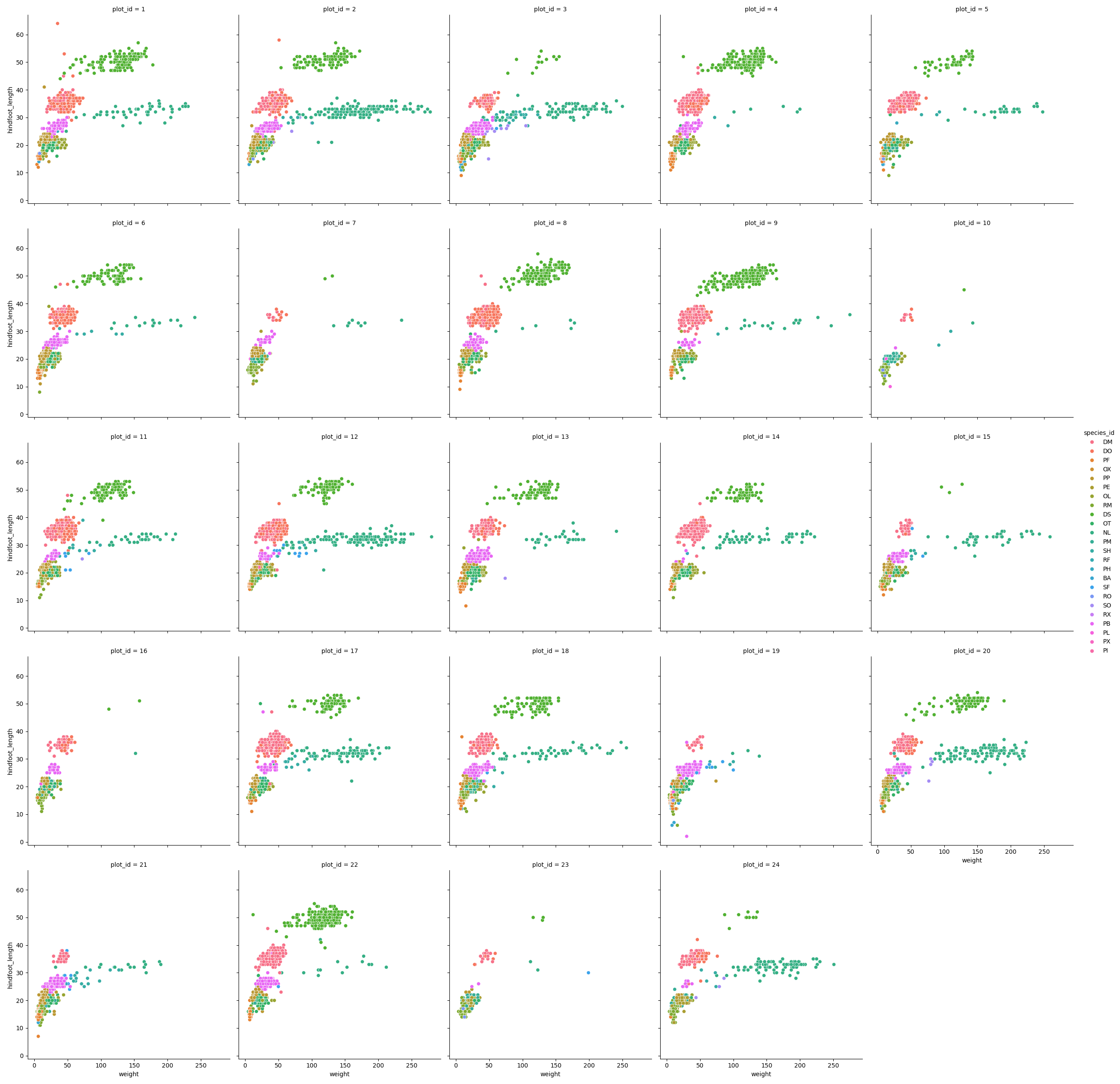
Challenge - facetting
Create a separate plot for each of the species that depicts how the average weight of the species changes through the years.
Answers
yearly_weight = surveys_complete.groupby(['year', 'species_id'])['weight'].mean().reset_index() sns.relplot(data=yearly_weight, x="year", y="weight", col="species_id", col_wrap=5, kind="line")
Challenge - facetting
Based on the previous exercise, visually compare how the weights of male and females has changed through time by creating a separate plot for each sex and an individual color assigned to each
species_id.Answers
yearly_weight = surveys_complete.groupby(['year', 'species_id', 'sex'])['weight'].mean().reset_index() sns.relplot(data=yearly_weight, x="year", y="weight", col="species_id", col_wrap=5, kind="line", hue="sex")
Further customization
The plots of seaborn, matplotlib, and other packages in Python can be customised heavily. It takes one look at the API of your favourite plot function to see the number of parameters it accepts. Then matplotlib as well on top of that has its own functions to modify its behaviour. In the end, the final look of the plots is a matter of personal preference or it can be dictated by external factors like publication standards.
Take for example a barchart that plots the counts of surveys per year:
sns.countplot(data=surveys_complete, x="year")
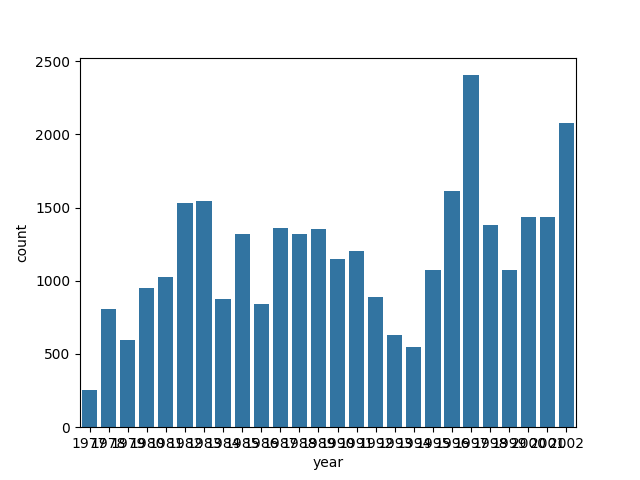
Notice that we use the year here as a categorical variable.
However, by doing so, we have the individual year labels overlapping with each other.
Functions in the matplotlib axis class provide a way to rotate the text of the x-axis labels:
fig = plt.figure()
ax = fig.add_subplot()
sns.countplot(data=surveys_complete, x="year", ax=ax)
ax.tick_params(axis='x', rotation=90)
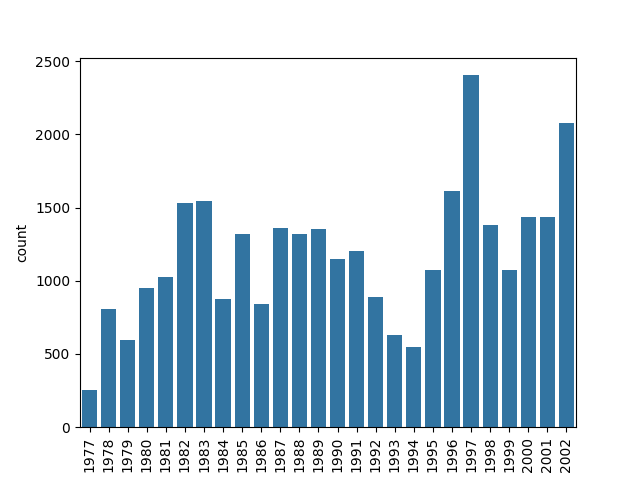
Challenge - customization
Please take another five minutes to either improve one of the plots generated in this exercise or create a beautiful graph of your own.
Here are some ideas:
- See if you can change thickness of lines for the line plot (in the time-series plotting part).
- Can you find a way to change the name of the legend? What about its labels?
- Use a different color palette (see https://seaborn.pydata.org/tutorial/color_palettes.html)
After creating your plot, you can save it to a file in your favourite format. You can easily change the dimension (and its resolution) of your plot by adjusting the appropriate arguments when you create the figure object.
fig = plt.figure(figsize=(3, 2), dpi=300)
ax = fig.add_subplot()
sns.scatterplot(data=surveys_complete, x="weight", y="hindfoot_length", alpha=0.25, hue="species_id", ax=ax)
plt.savefig("scatterplot.png")
Key Points
Data Workflows and Automation
Overview
Teaching: 40 min
Exercises: 50 minQuestions
Can I automate operations in Python?
What are functions and why should I use them?
Objectives
Describe why for loops are used in Python.
Employ for loops to automate data analysis.
Write unique filenames in Python.
Build reusable code in Python.
Write functions using conditional statements (if, then, else).
So far, we’ve used Python and the pandas library to explore and manipulate individual datasets by hand, much like we would do in a spreadsheet. The beauty of using a programming language like Python, though, comes from the ability to automate data processing through the use of loops and functions.
Automating data processing using For Loops
The file we’ve been using so far, surveys.csv, contains 25 years of data and is
very large. We would like to separate the data for each year into a separate
file.
Let’s start by making a new directory inside the folder data to store all of
these files using the module os:
import os
os.mkdir('data/yearly_files')
The command os.mkdir is equivalent to mkdir in the shell. Just so we are
sure, we can check that the new directory was created within the data folder:
os.listdir('data')
['plots.csv',
'portal_mammals.sqlite',
'species.csv',
'survey2001.csv',
'survey2002.csv',
'surveys.csv',
'surveys2002_temp.csv',
'yearly_files']
The command os.listdir is equivalent to ls in the shell.
In previous lessons, we saw how to use the library pandas to load the species data into memory as a DataFrame, how to select a subset of the data using some criteria, and how to write the DataFrame into a CSV file. Let’s write a script that performs those three steps in sequence for the year 2002:
import pandas as pd
# Load the data into a DataFrame
surveys_df = pd.read_csv('data/surveys.csv')
# Select only data for the year 2002
surveys2002 = surveys_df[surveys_df.year == 2002]
# Write the new DataFrame to a CSV file
surveys2002.to_csv('data/yearly_files/surveys2002.csv')
To create yearly data files, we could repeat the last two commands over and over, once for each year of data. Repeating code is neither elegant nor practical, and is very likely to introduce errors into your code. We want to turn what we’ve just written into a loop that repeats the last two commands for every year in the dataset.
Let’s start by writing a loop that prints the names of the files we want to create - the dataset we are using covers 1977 through 2002, and we’ll create a separate file for each of those years. Listing the filenames is a good way to confirm that the loop is behaving as we expect.
We have seen that we can loop over a list of items, so we need a list of years to loop over. We can get the years in our DataFrame with:
surveys_df['year']
0 1977
1 1977
2 1977
3 1977
...
35545 2002
35546 2002
35547 2002
35548 2002
but we want only unique years, which we can get using the unique method
which we have already seen.
surveys_df['year'].unique()
array([1977, 1978, 1979, 1980, 1981, 1982, 1983, 1984, 1985, 1986, 1987,
1988, 1989, 1990, 1991, 1992, 1993, 1994, 1995, 1996, 1997, 1998,
1999, 2000, 2001, 2002], dtype=int64)
Putting this into our for loop we get
for year in surveys_df['year'].unique():
filename='data/yearly_files/surveys' + str(year) + '.csv'
print(filename)
data/yearly_files/surveys1977.csv
data/yearly_files/surveys1978.csv
data/yearly_files/surveys1979.csv
data/yearly_files/surveys1980.csv
data/yearly_files/surveys1981.csv
data/yearly_files/surveys1982.csv
data/yearly_files/surveys1983.csv
data/yearly_files/surveys1984.csv
data/yearly_files/surveys1985.csv
data/yearly_files/surveys1986.csv
data/yearly_files/surveys1987.csv
data/yearly_files/surveys1988.csv
data/yearly_files/surveys1989.csv
data/yearly_files/surveys1990.csv
data/yearly_files/surveys1991.csv
data/yearly_files/surveys1992.csv
data/yearly_files/surveys1993.csv
data/yearly_files/surveys1994.csv
data/yearly_files/surveys1995.csv
data/yearly_files/surveys1996.csv
data/yearly_files/surveys1997.csv
data/yearly_files/surveys1998.csv
data/yearly_files/surveys1999.csv
data/yearly_files/surveys2000.csv
data/yearly_files/surveys2001.csv
data/yearly_files/surveys2002.csv
We can now add the rest of the steps we need to create separate text files:
# Load the data into a DataFrame
surveys_df = pd.read_csv('data/surveys.csv')
for year in surveys_df['year'].unique():
# Select data for the year
surveys_year = surveys_df[surveys_df.year == year]
# Write the new DataFrame to a CSV file
filename = 'data/yearly_files/surveys' + str(year) + '.csv'
surveys_year.to_csv(filename)
Look inside the yearly_files directory and check a couple of the files you
just created to confirm that everything worked as expected.
Writing Unique File Names
Notice that the code above created a unique filename for each year.
filename = 'data/yearly_files/surveys' + str(year) + '.csv'
Let’s break down the parts of this name:
- The first part is some text that specifies the directory to store our
data file in (data/yearly_files/) and the first part of the file name
(surveys):
'data/yearly_files/surveys' - We can concatenate this with the value of a variable, in this case
yearby using the plus+sign and the variable we want to add to the file name:+ str(year) - Then we add the file extension as another text string:
+ '.csv'
Notice that we use single quotes to add text strings. The variable is not
surrounded by quotes. This code produces the string
data/yearly_files/surveys2002.csv which contains the path to the new filename
AND the file name itself.
Challenge - Modifying loops
Some of the surveys you saved are missing data (they have null values that show up as NaN - Not A Number - in the DataFrames and do not show up in the text files). Modify the for loop so that the entries with null values are not included in the yearly files.
Let’s say you only want to look at data from a given multiple of years. How would you modify your loop in order to generate a data file for only every 5th year, starting from 1977?
Instead of splitting out the data by years, a colleague wants to do analyses each species separately. How would you write a unique CSV file for each species?
Building reusable and modular code with functions
Suppose that separating large data files into individual yearly files is a task that we frequently have to perform. We could write a for loop like the one above every time we needed to do it but that would be time consuming and error prone. A more elegant solution would be to create a reusable tool that performs this task with minimum input from the user. To do this, we are going to turn the code we’ve already written into a function.
Functions are reusable, self-contained pieces of code that are called with a single command. They can be designed to accept arguments as input and return values, but they don’t need to do either. Variables declared inside functions only exist while the function is running and if a variable within the function (a local variable) has the same name as a variable somewhere else in the code, the local variable hides but doesn’t overwrite the other.
Every method used in Python (for example, print) is a function, and the
libraries we import (say, pandas) are a collection of functions. We will only
use functions that are housed within the same code that uses them, but
we can also write functions that can be used by different programs.
Functions are declared following this general structure:
def this_is_the_function_name(input_argument1, input_argument2):
# The body of the function is indented
# This function prints the two arguments to screen
print('The function arguments are:', input_argument1, input_argument2, '(this is done inside the function!)')
# And returns their product
return input_argument1 * input_argument2
The function declaration starts with the word def, followed by the function
name and any arguments in parenthesis, and ends in a colon. The body of the
function is indented just like loops are. If the function returns something when
it is called, it includes a return statement at the end.
This is how we call the function:
product_of_inputs = this_is_the_function_name(2, 5)
The function arguments are: 2 5 (this is done inside the function!)
print('Their product is:', product_of_inputs, '(this is done outside the function!)')
Their product is: 10 (this is done outside the function!)
Challenge - Functions
- Change the values of the arguments in the function and check its output
- Try calling the function by giving it the wrong number of arguments (not 2) or not assigning the function call to a variable (no
product_of_inputs =)- Declare a variable inside the function and test to see where it exists (Hint: can you print it from outside the function?)
- Explore what happens when a variable both inside and outside the function have the same name. What happens to the global variable when you change the value of the local variable?
We can now turn our code for saving yearly data files into a function. There are many different “chunks” of this code that we can turn into functions, and we can even create functions that call other functions inside them. Let’s first write a function that separates data for just one year and saves that data to a file:
def one_year_csv_writer(this_year, all_data):
"""
Writes a csv file for data from a given year.
this_year -- year for which data is extracted
all_data -- DataFrame with multi-year data
"""
# Select data for the year
surveys_year = all_data[all_data.year == this_year]
# Write the new DataFrame to a csv file
filename = 'data/yearly_files/function_surveys' + str(this_year) + '.csv'
surveys_year.to_csv(filename)
The text between the two sets of triple double quotes is called a docstring and
contains the documentation for the function. It does nothing when the function
is running and is therefore not necessary, but it is good practice to include
docstrings as a reminder of what the code does. Docstrings in functions also
become part of their ‘official’ documentation, and we can see them by typing
help(function_name):
help(one_year_csv_writer)
Help on function one_year_csv_writer in module __main__:
one_year_csv_writer(this_year, all_data)
Writes a csv file for data from a given year.
this_year -- year for which data is extracted
all_data -- DataFrame with multi-year data
Or, when working in the Jupyter environment, adding a ? (question mark) after the function name:
one_year_csv_writer?
one_year_csv_writer(2002, surveys_df)
We changed the root of the name of the CSV file so we can distinguish it from
the one we wrote before. Check the yearly_files directory for the file. Did it
do what you expect?
What we really want to do, though, is create files for multiple years without
having to request them one by one. Let’s write another function that replaces
the entire for loop by looping through a sequence of years and repeatedly
calling the function we just wrote, one_year_csv_writer:
def yearly_data_csv_writer(start_year, end_year, all_data):
"""
Writes separate CSV files for each year of data.
start_year -- the first year of data we want
end_year -- the last year of data we want
all_data -- DataFrame with multi-year data
"""
# "end_year" is the last year of data we want to pull, so we loop to end_year+1
for year in range(start_year, end_year+1):
one_year_csv_writer(year, all_data)
Because people will naturally expect that the end year for the files is the last
year with data, the for loop inside the function ends at end_year + 1. By
writing the entire loop into a function, we’ve made a reusable tool for whenever
we need to break a large data file into yearly files. Because we can specify the
first and last year for which we want files, we can even use this function to
create files for a subset of the years available. This is how we call this
function:
# Load the data into a DataFrame
surveys_df = pd.read_csv('data/surveys.csv')
# Create CSV files
yearly_data_csv_writer(1977, 2002, surveys_df)
BEWARE! If you are using Jupyter Notebooks and you modify a function, you MUST re-run that cell in order for the changed function to be available to the rest of the code. Nothing will visibly happen when you do this, though, because defining a function without calling it doesn’t produce an output. Any cells that use the now-changed functions will also have to be re-run for their output to change.
Challenge: More functions
- Add two arguments to the functions we wrote that take the path of the directory where the files will be written and the root of the file name. Create a new set of files with a different name in a different directory.
- How could you use the function
yearly_data_csv_writerto create a CSV file for only one year? (Hint: think about the syntax forrange)- Make the functions return a list of the files they have written. There are many ways you can do this (and you should try them all!): either of the functions can print to screen, either can use a return statement to give back numbers or strings to their function call, or you can use some combination of the two. You could also try using the
oslibrary to list the contents of directories.- Explore what happens when variables are declared inside each of the functions versus in the main (non-indented) body of your code. What is the scope of the variables (where are they visible)? What happens when they have the same name but are given different values?
The functions we wrote demand that we give them a value for every argument.
Ideally, we would like these functions to be as flexible and independent as
possible. Let’s modify the function yearly_data_csv_writer so that the
start_year and end_year default to the full range of the data if they are
not supplied by the user. Arguments can be given default values with an equal
sign in the function declaration. Any arguments in the function without default
values (here, all_data) is a required argument and MUST come before the
argument with default values (which are optional in the function call).
def yearly_data_arg_test(all_data, start_year=1977, end_year=2002):
"""
Modified from yearly_data_csv_writer to test default argument values!
start_year -- the first year of data we want (default 1977)
end_year -- the last year of data we want (default 2002)
all_data -- DataFrame with multi-year data
"""
return start_year, end_year
start, end = yearly_data_arg_test(surveys_df, 1988, 1993)
print('Both optional arguments:\t', start, end)
start, end = yearly_data_arg_test(surveys_df)
print('Default values:\t\t\t', start, end)
Both optional arguments: 1988 1993
Default values: 1977 2002
The “\t” in the print statements are tabs, used to make the text align and be
easier to read.
But what if our dataset doesn’t start in 1977 and end in 2002? We can modify the function so that it looks for the start and end years in the dataset if those dates are not provided:
def yearly_data_arg_test(all_data, start_year=None, end_year=None):
"""
Modified from yearly_data_csv_writer to test default argument values!
all_data -- DataFrame with multi-year data
start_year -- the first year of data we want, Check all_data! (default None)
end_year -- the last year of data we want; Check all_data! (default None)
"""
if start_year is None:
start_year = min(all_data.year)
if end_year is None:
end_year = max(all_data.year)
return start_year, end_year
start, end = yearly_data_arg_test(surveys_df, 1988, 1993)
print('Both optional arguments:\t', start, end)
start, end = yearly_data_arg_test(surveys_df)
print('Default values:\t\t\t', start, end)
Both optional arguments: 1988 1993
Default values: 1977 2002
The default values of the start_year and end_year arguments in the function
yearly_data_arg_test are now None. This is a built-in constant in Python
that indicates the absence of a value - essentially, that the variable exists in
the namespace of the function (the directory of variable names) but that it
doesn’t correspond to any existing object.
Challenge - Variables
What type of object corresponds to a variable declared as
None? (Hint: create a variable set toNoneand use the functiontype())Compare the behavior of the function
yearly_data_arg_testwhen the arguments haveNoneas a default and when they do not have default values.What happens if you only include a value for
start_yearin the function call? Can you write the function call with only a value forend_year? (Hint: think about how the function must be assigning values to each of the arguments - this is related to the need to put the arguments without default values before those with default values in the function definition!)
As we’ve written it so far, the function yearly_data_arg_test associates
values in the function call with arguments in the function definition just based
on their order. If the function gets only two values in the function call, the
first one will be associated with all_data and the second with start_year,
regardless of what we intended them to be. We can get around this problem by
calling the function using keyword arguments, where each of the arguments in the
function definition is associated with a keyword and the function call passes
values to the function using these keywords:
start, end = yearly_data_arg_test(surveys_df)
print('Default values:\t\t\t', start, end)
start, end = yearly_data_arg_test(surveys_df, 1988, 1993)
print('No keywords:\t\t\t', start, end)
start, end = yearly_data_arg_test(surveys_df, start_year=1988, end_year=1993)
print('Both keywords, in order:\t', start, end)
start, end = yearly_data_arg_test(surveys_df, end_year=1993, start_year=1988)
print('Both keywords, flipped:\t\t', start, end)
start, end = yearly_data_arg_test(surveys_df, start_year=1988)
print('One keyword, default end:\t', start, end)
start, end = yearly_data_arg_test(surveys_df, end_year=1993)
print('One keyword, default start:\t', start, end)
Default values: 1977 2002
No keywords: 1988 1993
Both keywords, in order: 1988 1993
Both keywords, flipped: 1988 1993
One keyword, default end: 1988 2002
One keyword, default start: 1977 1993
Challenge - Modifying functions
Rewrite the
one_year_csv_writerandyearly_data_csv_writerfunctions to have keyword arguments with default valuesModify the functions so that they don’t create yearly files if there is no data for a given year and display an alert to the user (Hint: use conditional statements to do this. For an extra challenge, use
trystatements!)The code below checks to see whether a directory exists and creates one if it doesn’t. Add some code to your function that writes out the CSV files, to check for a directory to write to.
if 'dir_name_here' in os.listdir('.'): print('Processed directory exists') else: os.mkdir('dir_name_here') print('Processed directory created')
- The code that you have written so far to loop through the years is good, however it is not necessarily reproducible with different datasets. For instance, what happens to the code if we have additional years of data in our CSV files? Using the tools that you learned in the previous activities, make a list of all years represented in the data. Then create a loop to process your data, that begins at the earliest year and ends at the latest year using that list.
HINT: you can create a loop with a list as follows:
for years in year_list:
Key Points
Loops help automate repetitive tasks over sets of items.
Loops combined with functions provide a way to process data more efficiently than we could by hand.
Conditional statements enable execution of different operations on different data.
Functions enable code reuse.
